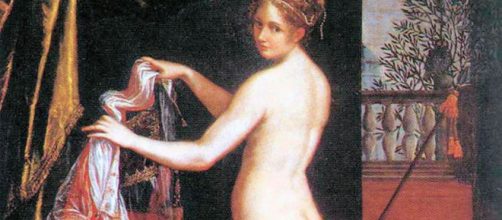Until the 1900s, paintings of undressed women made by women were a thorny subject. How thorny? A member of Michelangelo’s own family living under his own roof ordered the disrobed woman in Artemisia Gentileschi’s “Allegory of Inclination” covered up.
On second thought
Artnet identified Michelangelo’s live-in relative as his great-nephew Michelangelo Buonarroti the Younger. He is said to have ordered the cover-up: “To spare his wife and children the sight of a naked woman.”
But now, Artemisia’s painting will be stripped of its prudish drapery and restored to the original state of exposed flesh.
Well and good, but from the Artnet’s report, you might get the impression that except for Artemisia, there weren’t any pictures of women au natural painted by women besides her.
Granted, women weren’t allowed to study anatomy – even their own – until the 1900s, but Artemisia was not the only one to escape this limitation.
I’m thinking of Lavinia Fontana’s painting of a nude woman titled “Minerva Dressing,” made seven years before Artemisia made “Allegory of Inclination.”
Ahead of her time
Fontana described a female seen from the rear just before she dons her clothes. Yet the backside view comes across as more undressed than the frontal nudity in Artemisia’s picture even stripped of its drapery.
How did Fontana manage that?
The gesture of Minerva’s head is key. She looks over her shoulder at us, as if to ask why we are eying her in a state of undress. That implied question makes her nudity an issue that Fontana is clearly raising.
And naming the painting after Minerva, the Roman goddess of justice, suggests that Fontana was asking for justice for art history’s long-lived restriction on female painters.
“Minerva Dressing” distinguishes itself for another reason. Artemisia’s described her figure from the front and given the ton of paintings in history that picture nude women this way – hers seems ordinary.
Far fewer paintings of nude women are seen from the rear like Fontana’s. Ingres’s “La Grande Odalisque,” and, Manet’s “Luncheon on the Grass” come to mind.
Manet, by the way, used the head gesture for his female figure similar to Fontana’s by showing his nude looking over her shoulder in the viewers’ direction, as if to ask why we’re not minding our own business. But Fontana did it first and centuries earlier.
All that said, painters like Manet and Ingres, and even Artemisia get a lot of ink, while Fontana does not. But, thanks to the editors at Phaidon publishers, their 2019 book “Great Women Artists,” “Minerva Dressing” gets the spotlight in full color.
And as Phaidon editors point out, Fontan’s “Minerva Dressing” is one of the earliest nudes by a female painter, and one of the earlier to achieve success.
Even as a young artist, Fontana received commissions for altarpieces and “grand mythological scenes to rival those of male contemporaries of the Baroque movement.”
“Minerva Dressing” was Fontana’s last-known painting and the Phaidon editors rightly called it “a groundbreaking instance of a female nude painted by a female artist.”
Admittedly, nudes are a sensitive subject to paint. Get them right and you get stories that are psychologically charged like “Minerva Dressing.” But, get them wrong and you end up with an illustration for feminine hygiene products.


